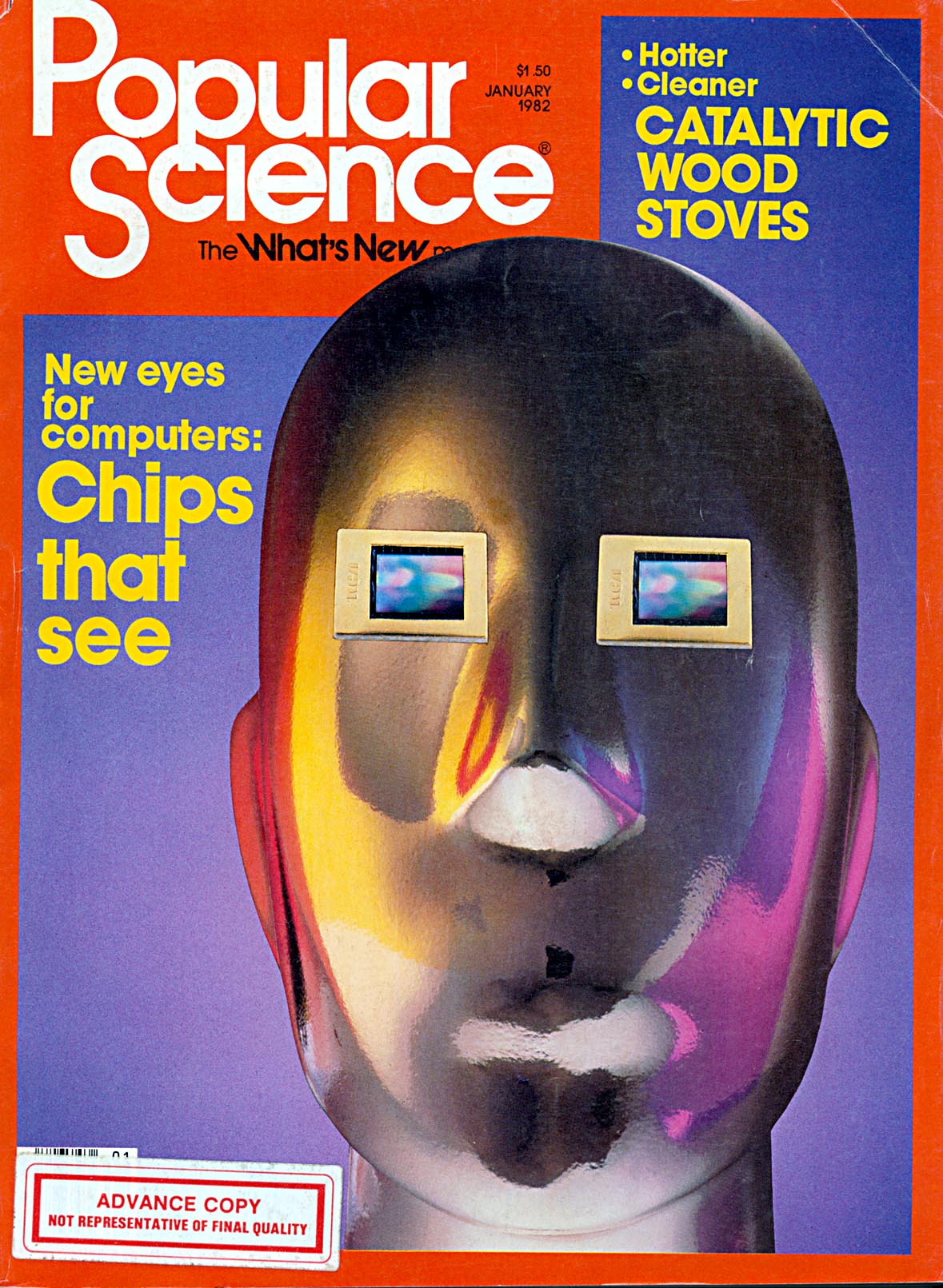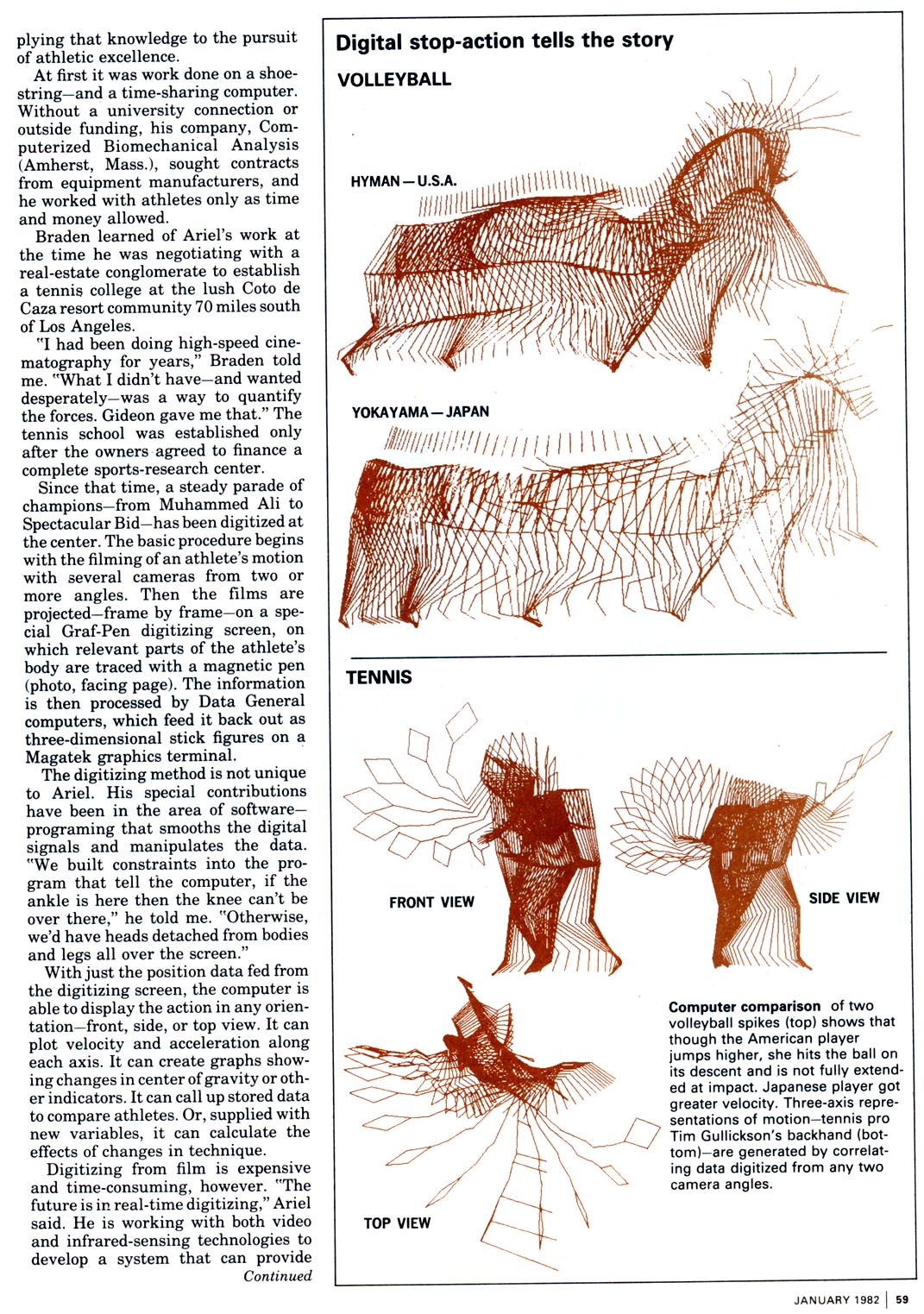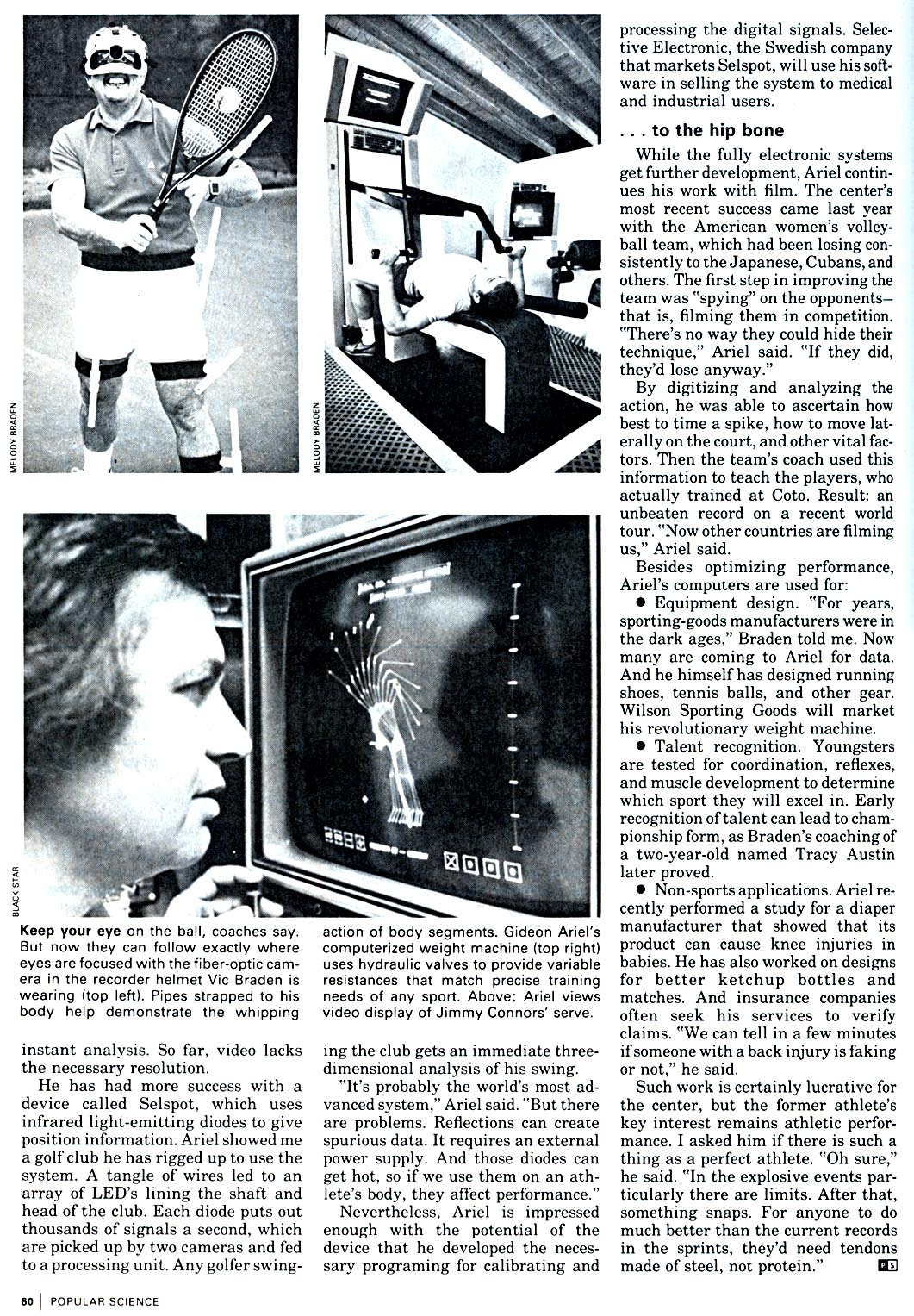Biomechanics - how computers extend athletic performance to the body's far limits
Now man and machine join on the sports field to boost phsyical output
By Daniel Ruby in Popular Science on Monday, January 25, 1982
Man and Machine: Boosting Athletic Performance Through Technology
In this article, Daniel Ruby explores the use of technology in sports training, focusing on the work of Gideon Ariel, a former Olympic shot-putter and inventor of a computerized weight machine. Ariel's machine offers variable resistance to match the physical demands of the sport being trained for. Ariel's Coto Research Center uses sophisticated computers, high-speed cameras, and other electronic devices to study biomechanics, the science that relates the physics of motion to human anatomy.
The center uses computer technology to quantify the velocities, accelerations, and angles generated in athletic performance, helping in talent recognition, training athletes, treating their injuries, and designing their equipment. Ariel's work has led to significant improvements in athletes' performance, including four-time Olympic discus champion Al Oerter, who threw 27 feet farther than his best gold-medal performance after working with Ariel.
The center also uses its technology for non-sports applications, such as designing better ketchup bottles and verifying insurance claims. Ariel believes that there are limits to athletic performance, particularly in explosive events, beyond which the human body cannot go without risking injury.
Tip: use the left and right arrow keys
Now man and machine join on the sports field to boost physical ouput
By DANIEL RUBY
TRABUCO CANYON, CALIF.
"Explode."
The heavyset man yelled in my ear as I strained to jolt the bar upward. But it was much heavier near the top of its travel than it had been at first. I lost momentum.
"Try again," he said disapprovingly. But my second bench press-and third-proved just as feeble.
A color graph appeared on the screen, displaying a shortage of footpounds where I'd need them most for heaving an iron ball. "You'll never make it as a shot-putter, my friend," said Gideon Ariel, a one-time Olympic shot-putter himself and inventor of the computerized weight machine that had just defeated me.
Ariel's exercise machine, which is programmed to offer variable resistance to match the physical demands of the sport being trained for, is just one of the electronic devices he uses at the Coto Research Center to quantify the forces and stresses generated in athletics. Sophisticated computers, digitizing pens and hardware, highspeed cameras, force plates, and infrared detectors are the instruments that turn an already first-class sports complex (tennis courts, running track, gym, swimming pools, equestrian grounds) into the world's premier laboratory for the study of biomechanics-the science that relates the physics of motion to human anatomy.
The basis for Ariel's work is that old con man's truth: The hand is quicker than the eye. So are the feet, head, and every other part of an athlete's body. Only by slowing down the motion on film or videotape can anyone really tell what happens when a racket hits a ball or a foot meets a track.
Thigh bone's connected .. .
Of course, the use of film alone is nothing new to sport. What is newand is becoming a powerful tool in recognizing talent, training athletes, treating their injuries, and designing their equipment-is the use of computer technology to quantify the velocities, accelerations, and angles generated in athletic performance.
"It's basic physics," Ariel said, using as an example his work with four-time Olympic discus champion Al Oerter. "We know that for the discus to go so far it must leave the hand at a certain velocity and a certain angle. So we work backward. For the discus to have that velocity, then the hand must have that velocity. For that to happen, the forearm must be moving so, then the upper arm, the torso, and so on down to the feet. We created a computer model of the optimum throw and then tried to teach the athlete to do that."
At age 43, after working with Ariel, Oerter threw 27 feet farther than his best gold-medal performance. Now he is training for a comeback at the 1984 Olympics.
The interdependence of body parts is true of all sports. Ariel's coresearcher at Coto, psychologist and tennis guru Vic Braden, uses the analogy of a whip. "Power supply comes from efficiently transferring shock from one body segment to another and finally into the implement or ball." Or as Ariel likes to say: "You can't shoot a cannon from a canoe."
Ariel himself once shot cannons-or tried to. Competing for his native Israel in the 1960 and '64 Olympics, his best shot puts landed far short of the gold. But if he lacked natural ability with 16-pound shots, he had it to spare for work with computers. He came to the U.S. and received his doctorate in computer science, then set about ap-
50 1 POPULAR SCIENCE
plying that knowledge to the pursuit of athletic excellence.
At first it was work done on a shoestring-and a time-sharing computer. Without a university connection or outside funding, his company, Computerized Biomechanical Analysis (Amherst, Mass.), sought contracts from equipment manufacturers, and he worked with athletes only as time and money allowed.
Braden learned of Ariel's work at the time he was negotiating with a real-estate conglomerate to establish a tennis college at the lush Coto de Caza resort community 70 miles south of Los Angeles.
"I had been doing high-speed cinematography for years," Braden told me. "What I didn't have-and wanted desperately-was a way to quantify the forces. Gideon gave me that." The tennis school was established only after the owners agreed to finance a complete sports-research center.
Since that time, a steady parade of champions-from Muhammed Ali to Spectacular Bid-has been digitized at the center. The basic procedure begins with the filming of an athlete's motion with several cameras from two or more angles. Then the films are projected-frame by frame-on a special Graf-Pen digitizing screen, on which relevant parts of the athlete's body are traced with a magnetic pen (photo, facing page). The information is then processed by Data General computers, which feed it back out as three-dimensional stick figures on a Magatek graphics terminal.
The digitizing method is not unique to Ariel. His special contributions have been in the area of softwareprograming that smooths the digital signals and manipulates the data. "We built constraints into the program that tell the computer, if the ankle is here then the knee can't be over there," he told me. "Otherwise, we'd have heads detached from bodies and legs all over the screen."
With just the position data fed from the digitizing screen, the computer is able to display the action in any orientation-front, side, or top view. It can plot velocity and acceleration along each axis. It can create graphs showing changes in center of gravity or other indicators. It can call up stored data to compare athletes. Or, supplied with new variables, it can calculate the effects of changes in technique.
Digitizing from film is expensive and time-consuming, however. "The future is in real-time digitizing," Ariel said. He is working with both video and infrared-sensing technologies to develop a system that can provide Continued Digital stop-action tells the story
VOLLEYBALL TENNIS
Computer comparison of two volleyball spikes (top) shows that though the American player jumps higher, she hits the ball on its descent and is not fully extended at impact. Japanese player got greater velocity. Three-axis representations of motion-tennis pro Tim Gullickson's backhand (bottom)-are generated by correlating data digitized from any two camera angles.
JANUARY 1982 ~ 59
Keep your eye on the ball, coaches say. But now they can follow exactly where eyes are focused with the fiber-optic camera in the recorder helmet Vic Braden is wearing (top left). Pipes strapped to his body help demonstrate the whipping instant analysis. So far, video lacks the necessary resolution.
He has had more success with a device called Selspot, which uses infrared light-emitting diodes to give position information. Ariel showed me a golf club he has rigged up to use the system. A tangle of wires led to an array of LED's lining the shaft and head of the club. Each diode puts out thousands of signals a second, which are picked up by two cameras and fed to a processing unit. Any golfer swing action of body segments. Gideon Ariel's computerized weight machine (top right) uses hydraulic valves to provide variable resistances that match precise training needs of any sport. Above: Ariel views video display of Jimmy Connors' serve.
ing the club gets an immediate threedimensional analysis of his swing.
"It's probably the world's most advanced system," Ariel said. "But there are problems. Reflections can create spurious data. It requires an external power supply. And those diodes can get hot, so if we use them on an athlete's body, they affect performance."
Nevertheless, Ariel is impressed enough with the potential of the device that he developed the necessary programing for calibrating and processing the digital signals. Selective Electronic, the Swedish company that markets Selspot, will use his software in selling the system to medical and industrial users.
. to the hip bone
While the fully electronic systems get further development, Ariel continues his work with film. The center's most recent success came last year with the American women's volleyball team, which had been losing consistently to the Japanese, Cubans, and others. The first step in improving the team was "spying" on the opponentsthat is, filming them in competition. "There's no way they could hide their technique," Ariel said. "If they did, they'd lose anyway."
By digitizing and analyzing the action, he was able to ascertain how best to time a spike, how to move laterally on the court, and other vital factors. Then the team's coach used this information to teach the players, who actually trained at Coto. Result: an unbeaten record on a recent world tour. "Now other countries are filming us," Ariel said.
Besides optimizing performance, Ariel's computers are used for:
- Equipment design. "For years, sporting-goods manufacturers were in the dark ages," Braden told me. Now many are coming to Ariel for data. And he himself has designed running shoes, tennis balls, and other gear. Wilson Sporting Goods will market his revolutionary weight machine.
- Talent recognition. Youngsters are tested for coordination, reflexes, and muscle development to determine which sport they will excel in. Early recognition of talent can lead to championship form, as Braden's coaching of a two-year-old named Tracy Austin later proved.
- Non-sports applications. Ariel recently performed a study for a diaper manufacturer that showed that its product can cause knee injuries in babies. He has also worked on designs for better ketchup bottles and matches. And insurance companies often seek his services to verify claims. "We can tell in a few minutes if someone with a back injury is faking or not," he said.
Such work is certainly lucrative for the center, but the former athlete's key interest remains athletic performance. I asked him if there is such a thing as a perfect athlete. "Oh sure," he said. "In the explosive events particularly there are limits. After that, something snaps. For anyone to do much better than the current records in the sprints, they'd need tendons made of steel, not protein."
60 1 POPULAR SCIENCE




